Tags
1905, Houston Street, Little Hungary, lower east side, Marcus Braun, Max Schwartz, President, Rigo Jancsi, Samuel S. Koenig, Teddy Roosevelt
This is the story of President Roosevelt’s 1905 visit to Little Hungary, at 257 Houston Street, just around the corner of our building on Norfolk Street. Max Schwartz, owner of Liberty Hall and Little Hungary (also called Liberty Cafe) had many times visited our building and so did Samuel S. Koenig and Marcus Braun (they are referred to in the below quoted contemporary news accounts.) Our esteemed rabbis (both from Anshi Chesed and Ohab Zedek) attended and organized meetings either in Liberty Hall or in Max Schwartz’s “bohemian” establishment. We’ll have more entries with these stories at later dates , for now we focus on President Roosevelt’s visit in “Little Hungary” and add a few loosely connected stories about this place.
For the first time since the days when he was governor of New York, President Roosevelt revisited the heart of the east side, where as guest of the Hungarian Republican Club, he dined and spoke at the restaurant “Little Hungary.”
The attendance of President Roosevelt is the result made when he was Governor, that, if ever became President he would attend a dinner to be tendered by the Hungarian Republicans of his home city.
On May 31, 1899, Samuel S. Koenig, now Republican leader of the Sixteenth Assembly District, in rising to a toast at a dinner given at the Café Boulevard by the Hungarian Republican Club in honor of Governor Roosevelt, said that he was convinced there would be ample opportunity by 1904 to tender a dinner to “his Excellency, Theodore Roosevelt, President of the United States.”
A few days following November 8 Election Day [1904] Marcus Braun reminded President Roosevelt of his promise of the days of his Governorship. The President recalled his promise and agreed to set a date for his coming. He selected Feb. 14, St. Valentine’s day.
Six years ago Gov. Roosevelt was entertained, at the same place, and when he was Police Commissioner he became familiar with every turn of the narrow streets through which he passed tonight . In his police escort tonight there were some of the men who wore their badges under him when he headed “the force.” and who still addressed him “Mr. Commissioner.” After taking dinner at “Little Hungary” he would often go to visit some poverty-stricken family in a back tenement and relieve their needs. Many stories are told of these visits, which were somewhat after the fashion of those of Haroun-al-Raschid.
On the eve of his presidential visit to “Little Hungary” security was so tight that President Roosevelt had little chance to slip away from his handlers for his customary neighborhood outings.
President McKinley’s assassination, that originally propelled Teddy Roosevelt to Presidency, was still a painful public memory. “Special Precautions Taken to Safeguard Mr. Roosevelt in Crowded Tenement District”, assured his readers the February 14, 1905 headline of The Washington Times.
The police did not want to take any chances. At 6 o’clock the police began to clear the block In Houston-st. between Avenue A and Avenue B. The big restaurant on the south side and in the middle of the block. where the dinner to he President was to be given, already flashed forth in electric flame “Welcome to Our President,” and similar glowing signs appeared on the fronts of buildings on thenorth side of the street, while flags and bunting [lightweight worsted wool fabric] were displayed liberally by the various shops. Thousands of people were in the block then, gazing at the decorations and signs. The tenants of houses in the cleared block crowded the fire escapes and leaned out of front windows.
In a short time the people anxious to see the President’s arrival were posted in this way by the hundred. Inspector Schmittberger saw that this would not do. as it would have been possible for a crank from any one of a hundred points to have fired a pistol or thrown a bomb.
A troop of mounted police rode slowly into the crowd, and, working east and west, gradually moved the sightseers into the side streets, where strong police lines were established to keep them back.
The crowd was in the best of humor, and no disorder or resistance occurred.
The patient people allowed themselves to be herded back, and in a remarkably short time the street before the restaurant and for two blocks in either direction, as well as for half a block down the side streets, was absolutely cleared.
Next day brought a real pilgrimage to Max Schwartz’s Little Hungary. “Anarchist Rub Elbows with Society in Hall Where He Dined”, “Rush Overwhelms Place” reports the February 16 issue of the New York Times.
The crowds that came, women in opera cloaks escorted by men in faultless evening attire, gave gasps of surprise as the doors swung open as on a scene from fairyland and closed on the squalor of an east-side street.
The table where the chief guests were seated had been placed in a part of the restaurant where the ordinary east side crowd gathers to drink Caravan tea in glasses, with great slices of lemon in it, and discuss the latest news from the old country.
For many years to come people recalled the president’s visit to this special spot of the East Side.
I have not been there for many years, but I believe that the chair on which the God of Blare sat is still on exhibition, and that the plan of the Holy Supper is still on the wall – with some vitriol about the ex-President, a 1928 article titled “Red-Ink Days” in H.L. Mencken’s publication The American Mercury Magazine reminiscences.
By then the chair was gone, eaten up by flames. On June 22, 1922 The Evening Post reports “Roosevelt Chair Burned in Fire in Little Hungary.”
A few weeks ago Theodore Roosevelt Jr. attended a business men’s meeting in the restaurant and the chair [of his father] was brought out for him to sit in. Immediately afterward It was restored to Its wrappings and taken back to tho storeroom in the cellar – where the fire started.
Downstairs in the restaurant, where 125 men and women were dining. [Jancsi] Rigo “the Gypsy Violinist,” one time husband of Clara Ward, led his orchestra in the Hungarian Rhapsody while the diners marched out in good order.
from left to right: Little Hungary poster of Jancsi Rigo; 1922 Oakland Tribune news report of the fire; Jancsi Rigó with Clara Ward, Princess Caraman-Chimay of Belgium, as seen by Toulouse-Lautrec in 1897.
Little Hungary kept serving locals along with East Side visitors and proudly claimed the title of the most bohemian place in the heart of the ghetto.

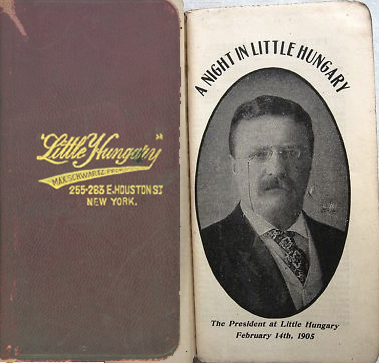
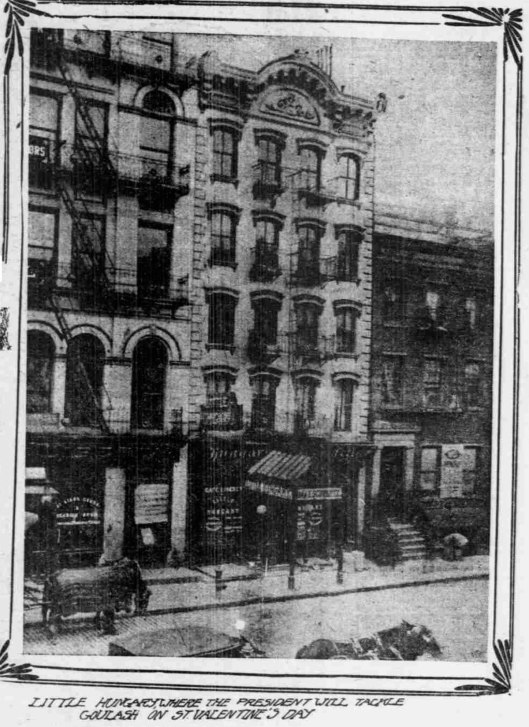
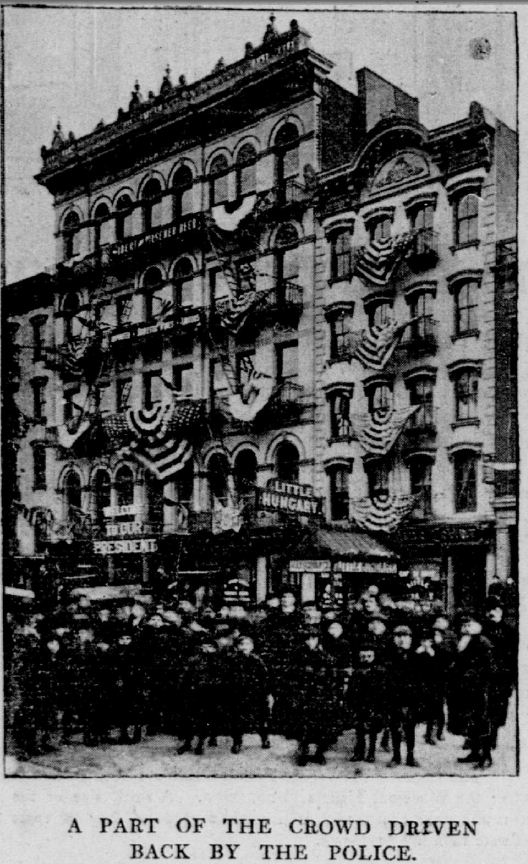
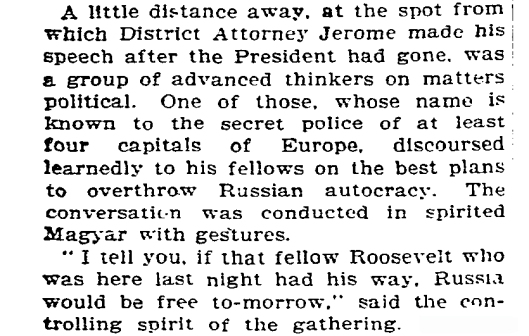
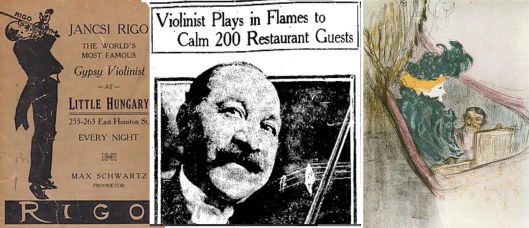
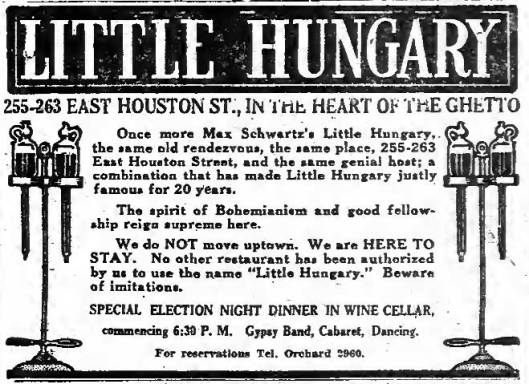
Thank you for posting this fascinating article! I am preparing my master thesis on the political life of Marcus Braun and would very much like to get in touch with you in order to better understand his position and his work within the Jewish community in New York.
I would very much appreciate it if you would contact me via email: JakobLanman@gmail.com
Best regards,
Jakob Lanman Niese
Pingback: Lost Neighborhoods of New York: Goulash Row
Pingback: Lost Neighborhoods of NYC: “Goulash Row” | Bygone NYC
Pingback: Lost Neighborhoods of New York: Goulash Row – Village Preservation